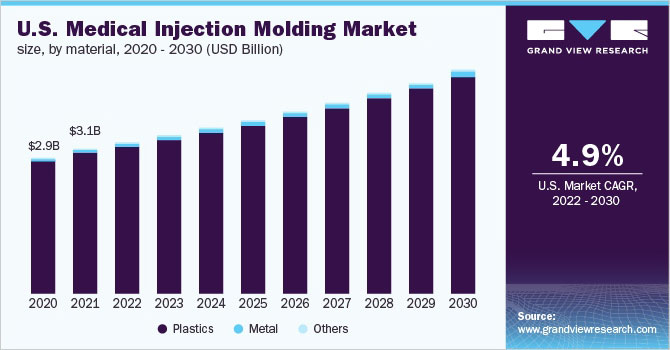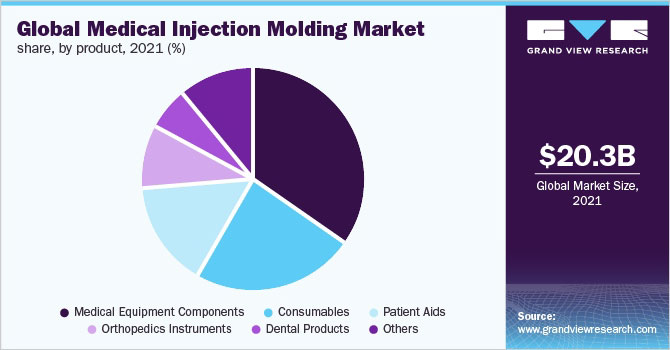|
Global Medical Injection Molding
Market
As per a recent report by “ Grand
View Research”, the global medical injection molding market size was estimated
at USD 20.30 billion in 2021 and is expected to expand at a compound annual
growth rate (CAGR) of 5.7% from 2022 to 2030.
This growth is poised to be
driven by the demand for mass production of identical medical components with
design flexibility and precision at lower costs. The number of hospital visits
and hospitalizations has increased manifold since the advent of the COVID-19
pandemic.

This has augmented the demand for various devices in
emergency room products, MRI equipment, drug delivery systems, and surgical
devices, among other devices used in hospitals.
The market in the U.S. has undergone a
transformation as a result of the COVID-19 pandemic, with players acquiring and
expanding their capacity to satisfy the market's growing demands.
The regional industry is predicted to witness growth
in the coming years, owing to various factors such as the increasing number of
manufacturers adopting medical injection molding technology, the rising demand
for medical equipment, and the rising healthcare expenditure in the country.
Medical-grade products, components, equipment, and
tools require a production process that meets medical hygiene standards.
Injection molding is a viable approach for producing complex medical products,
components, equipment, and tools. Medical-grade injection-molded products are in
high demand globally because they are long-lasting and are inherently resistant
to pollutants and chemicals. These factors are expected to boost the industry
demand.
Medical injection molding (MIM) can be utilized to
develop complicated and basic medical devices. In general, it is best suited for
pieces that have thickness and weight less than 6 mm thick and 100 g,
respectively. However, the advent of new binder removal procedures has enabled
the processing of cross sections of parts of medical devices that are larger
than 12.5 mm and weigh up to 400 g.
In-house injection molding of injection molded
components by OEMs can be a considerable issue in terms of productivity, cost,
and quality. Many companies are outsourcing injection molding services because
it provides benefits such as strategic optimization, reduced inventory,
economies of scale, quick startup time, and increased quality.
Material Insights
The plastics material segment led the industry and
accounted for 98.8% of the global revenue share in 2020. Plastic injection
molding is a viable approach for producing complex medical products.
Medical-grade injection-molded goods are in high demand because they are
long-lasting, inherently resistant to pollutants and chemicals, and provide
economies of scale to major manufacturing companies.
The rising use of engineering-grade plastic resins
for medical and pharmaceutical products is due to factors such as
hightemperature endurance, metal tolerance, and high tensile strength.
Furthermore, these resins allow for a reduction in product weight, manufacturing
waste, and manufacturing costs, leading to their use in medical device injection
molding.
The demand for metals in the manufacturing process
is likely to grow at a CAGR of 8.2% during the forecast period. Metal injection
molding is an excellent method for producing delicate, tiny, and precision metal
components for the medical industry. The metal injection molding process employs
both thermoplastic and powder metallurgy injection molding.
System Insights
Hot runner systems led the medical injection molding
market and accounted for more than 57.8% of the global revenue share in 2020.
The growth is attributed to various advantages of these systems, such as faster
cycle time and lower pressure required to drive the molten mixture into the mold
cavity, elimination of waste due to the elimination of runners, the housing of
larger parts with greater volume of production, and an increase in the
uniformity & quality of parts.
Hot sprinter molds are made up of two plates that
are heated by a sophisticated structure. This structure keeps liquid
thermoplastics at the same temperature as their warming chamber. There are two
types of hot sprinters: inside warmed sprinters and distantly warmed sprinters.
The hot sprinter framework keeps the material in a liquid state throughout the
sprinter method, until it enters the form pit.
The cold runner system market is likely to advance
at a CAGR of 5.4% during the forecast period. The use of a cold runner system is
based on its benefits such as ease of maintenance and cost effectiveness; it is
suited for a wide range of polymers. This technology is a viable choice because
it produces higher-quality parts. As a result of reduced initial investments
compared to other systems, the use of cold runner systems is increasing at a
rapid pace.
A cold runner system is a physical tube that is not
heated and is used to inject plastic through a sprue. Its mold base is made up
of two or three plates. The injection technique employs molten thermoplastic,
which is injected into the molds through a nozzle via a sprue. Runners are kept
at the same temperature as molds in this system.
Product Insights
The medical equipment components segment led the
market and accounted for around 34.9% of the global revenue share in 2021.
Pharmaceutical companies having a presence in the United States include 3M
Health Care Business, Johnson & Johnson, Abbott Laboratories, and Pfizer Inc.
Ongoing improvements in the field of surgery, such as standardization of methods
and technical advancements, are expected to propel the medical sector forward
and fuel the demand for these products.
The in-house injection molding of injection molded
components by OEMs can be a considerable issue in terms of productivity, cost,
and quality. Many companies are outsourcing injection molding services because
it provides streamlined inventory, optimization, economies of scale, quick
start-up time, and enhanced quality, among other benefits, all of which are
projected to drive industry demand throughout the forecast period.

The increasing geriatric population globally that is
suffering from oral diseases, demand for medical tourism relating to dental
treatment, and the launch of multiple initiatives for oral health care for the
public by the government, are few of the growth enablers for the industry.
Furthermore, people are becoming more conscious of cosmetic dental treatment,
which helps to improve looks and keep fresh breath, which is expected to boost
the industry growth.
Regional Insights
Asia Pacific led the market and accounted for 40.6%
of the global revenue share in 2021. The healthcare industry in the region is
expected to grow at a swift pace owing to several factors, including the aging
population coupled with urbanization, improving the standard of living, and
expanding healthcare infrastructure in countries such as China, India, and
Japan.
The ongoing COVID-19 pandemic has further increased
hospitalization and in turn boosted the demand for disposable medical devices,
thereby propelling the industry growth.
In North America, the rising healthcare costs and an
aging population are expected to boost the medical sector. Government
authorities are anticipated to invest considerably in healthcare facilities
following the COVID-19 pandemic. The increasing use of injection molding to
manufacture a variety of parts and components for medical devices is likely to
boost industry growth in the coming years.
The medical industry in the U.S. is among the most
technically advanced in the world, thereby contributing to the surging demand
for medical devices. Moreover, it has a high per capita income, along with
increased health awareness among the masses. All these factors contribute to the
augmented adoption of this technology in the healthcare sector, thereby boosting
industry growth.
The regulatory framework for the medical device
sector in Europe is being changed, with the goal of raising medical device
safety and performance standards. As a result, during the forecast period,
demand for high-quality, biocompatible, recyclable, and innovative plastics in
medical devices is expected to increase, which is expected to boost medical
injection molding services.
( Re :
https://www.grandviewresearch.com/industry-analysis/medical-injection-molding-market
)
|

